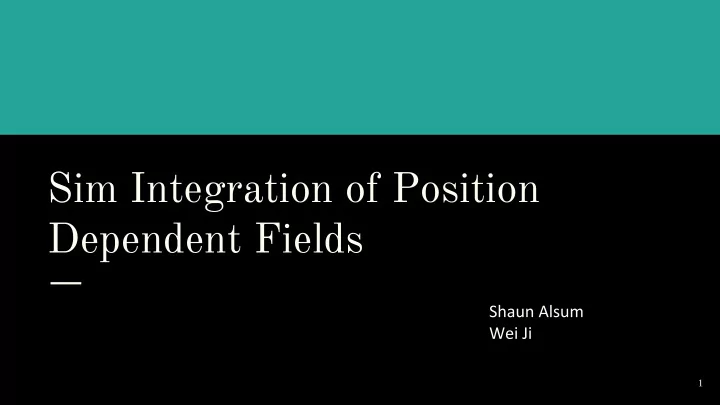

Sim Integration of Position Dependent Fields 1
Recap: what is Plan A? Use full field dependent functionality of NEST Every location/time will have field dependence Contrasts with plan B which uses some single field for all locations and times.
Goals Required for Plan A background model - Correctly simulate the positional response of the detector, taking into account changes in the electric field. - Correctly simulate the S1 and S2 response in the detector as a function of the changing electric field at various locations. This will also be used for tritium and dd calibration studies.
Flow Chart
The Field Maps The Field maps contain eight values for each entry. The entries form a cubic lattice in real space. X, Y, and Z: real space coordinates (denoted as Xi, Yi, Zi in the map). E : the electric field magnitude at real (X, Y, Z) X_S2, and Y_S2: the location electrons will drift to if they originate at real (X, Y, Z). (denoted as S2x, S2y in the map). drift: the time it takes for an electron to drift from real (X, Y, Z) to (X_S2, Y_S2) at the surface. Event classification: flags the fate of the electron. Made it to the surface, eaten by wall, eaten by grid, etc.
Implementation approach Interpolate E, X_S2, Y_S2, and drift using surrounding Field Map entries. Feed these into NEST and FastSim Throw edge data away: If not all of the grid points making up the cube immediately surrounding the event have values for E, X_S2, Y_S2, and drift, chuck out the event. Updated the ER portion of NEST Using a the run03 FastSim hitmap but in S2 space
For Users In order to utilize the updates to LUXSim, use the following commands. - /LUXSim/detector/EFieldFromFile true - Activates the portion of the code that uses an external field map - /LUXSim/detector/EFieldFile [path-to-file] - This tells the simulation which file to use - /LUXSim/physicsList/s1gain [value <1] - This sets the value of g1 and must be <1 in order for FastSim to be used - /LUXSim/physicsList/s2gain [value <1] - This sets the value of the extraction efficiency and must be <1 in order for FastSim to be used
Verification: Selected data - Looked at three tritium calibrations that occurred very close to krypton runs used to generate field maps. - September 2014 - February 2015 - September 2015 - Only selected events with a single paired S1 and S2. - Also made cuts on S1, and S2 to isolate the tritium band. Sep 2014: - log(S1) < 2.0 Sep 2014 Feb 2015 Sep 2015 - 3.1 < log(S2) < 4.0 Feb 2015: Log10(S2/S1) Log10(S2/S1) Log10(S2/S1) - log(S1) < 2.0 - 3.1 < log(S2) < 4.0 Sep 2015: - log(S1) < 2.0 - 3.0 < log(S2) < 4.2 S1 (phd) S1 (phd) S1 (phd)
Verification: positional response Sep 2014 DData Sim Sep 2015 - XY response good. - Drift time has problems - missing the bulge.
Verification: positional response Sep 2014 Simulation Sim Sep 2015 - XY response good. - Drift time has problems - missing the bulge.
Verification: drift time samples histogram 2015 2014 - Missing tail - Missing slope Data - Confirms drift time problem Sim
Verification: data back to real xyz space Sep 2014 r=18cm Data Sep 2015 - event in XYZ space is uniformly distributed.
Verification: data back to real xyz space r=18cm Sep 2014 Simulation - XY distribution is close Sep 2015 to uniformity. - Drift time has problems - missing the cathode corner.
Energy Spectra Comparing the energy spectrum from Data and Simulation. Both are obtained via W(S1/g1 + S2/g2) - Low energy rise in simulation - Sim underpredicts around 3-4 and 6-7 keVee
Light Yield vs Electric field Comparison:
Log S2/S1 vs S1 band:
Log S2 vs Log S1 band:
Conclusion - Simulation machinery in place - Many aspects work well - XY position - S1 yield trends with field as it should - Some aspects don’t - Drift time - Bands and energies don’t quite match up all the time
Backup
Verification: positional response To test that the alterations to positional response we directly altered columns S2x and S2y in one of Lucie’s field maps (September 2014) to be 20 cm and 0 cm respectively. We then ran the same simulation on both the altered and unaltered versions to compare the results. Altered field map Lucie’s map As expected, the signal is centered around (20, 0) in the altered case, The real map is more isotropic.
Verification: Selected data - Looked at three tritium calibrations that occurred very close to krypton runs used to generate field maps. - September 2014 - February 2015 - September 2015 - Only selected events with a single paired S1 and S2. - Also made cuts on S1, and S2 to isolate the tritium band. Sep 2014: - log(S1) < 2.0 - 3.1 < log(S2) < 4.0 Feb 2015: - log(S1) < 2.0 - 3.1 < log(S2) < 4.0 Sep 2015: - log(S1) < 2.0 - 3.0 < log(S2) < 4.2
S1
S2
Energy
Verification: Compare light yield vs ESep 2014 data
Verification: Compare light yield Sep 2015 data
Light Yields
Light Yields Comparison
Bands With Means
x_del, y_del Sep 2014 Sep 2015
Recommend
More recommend